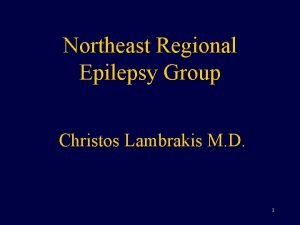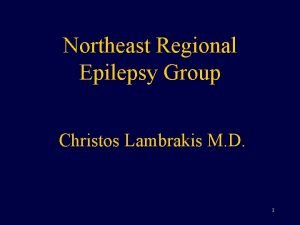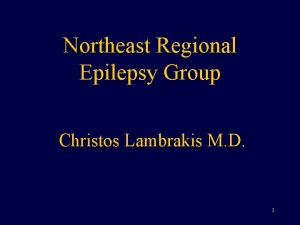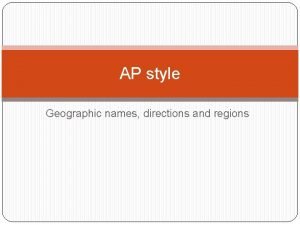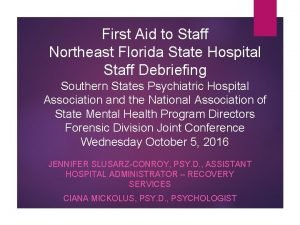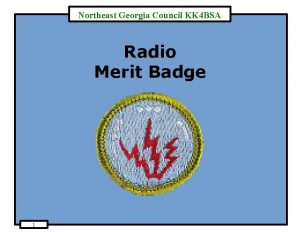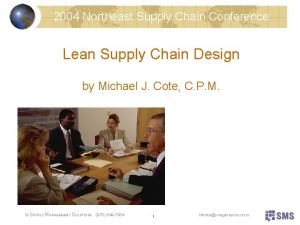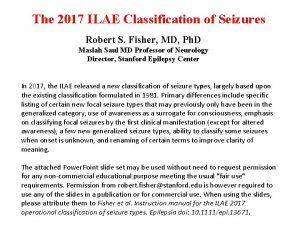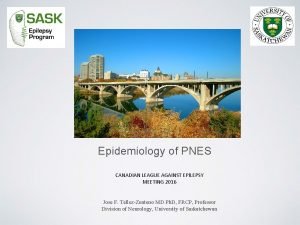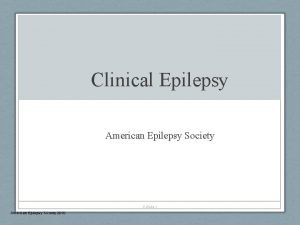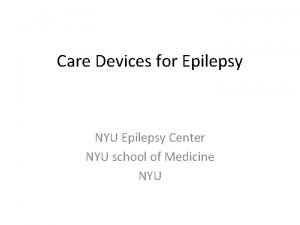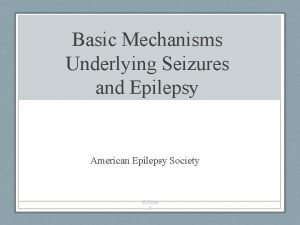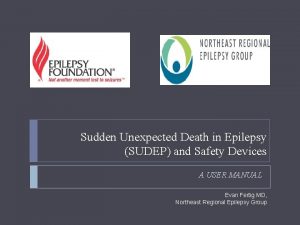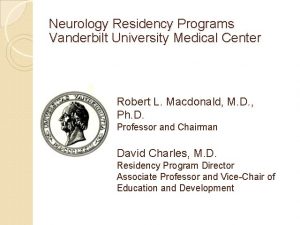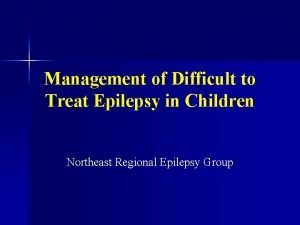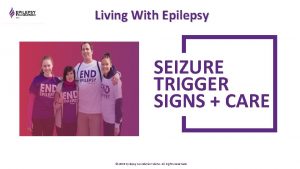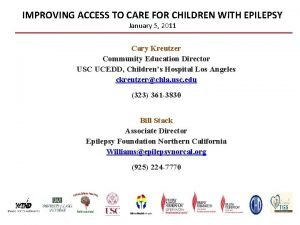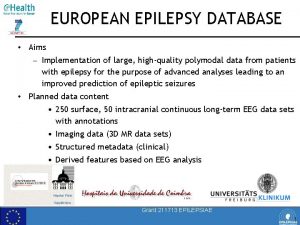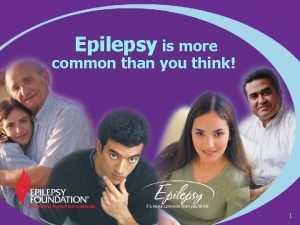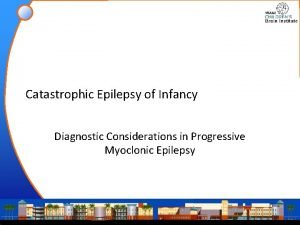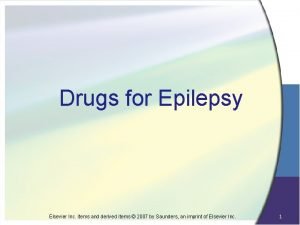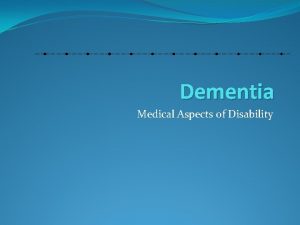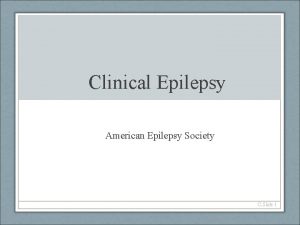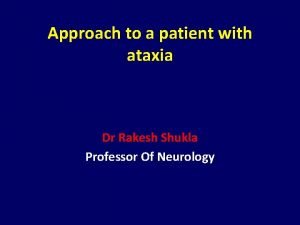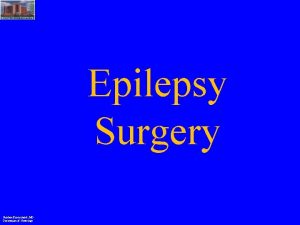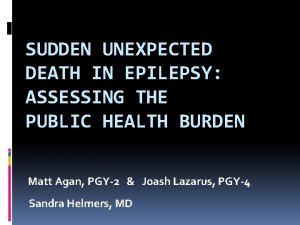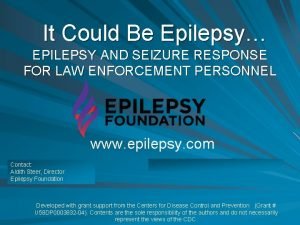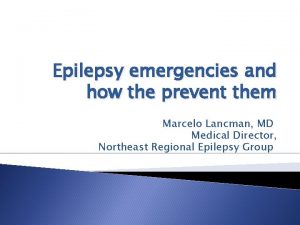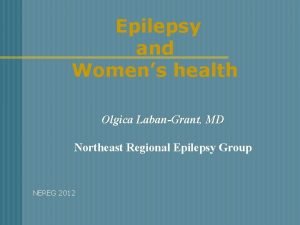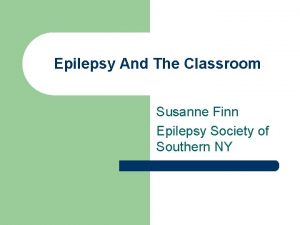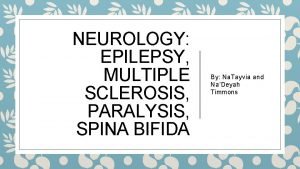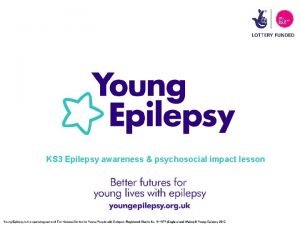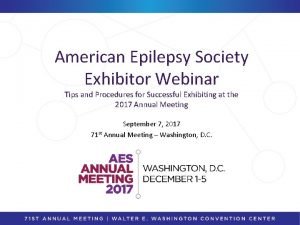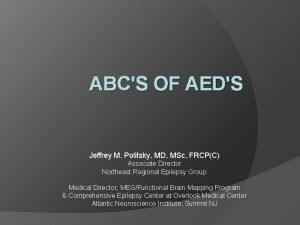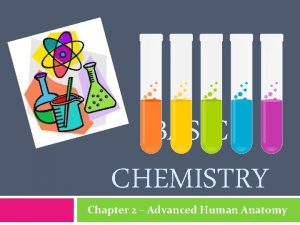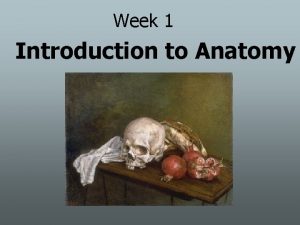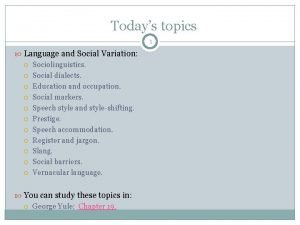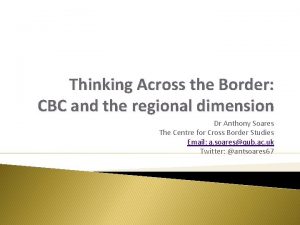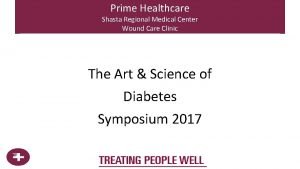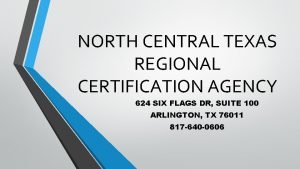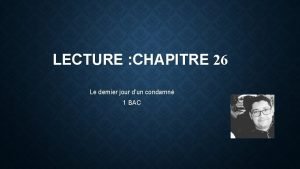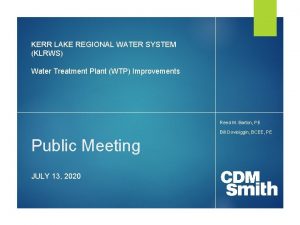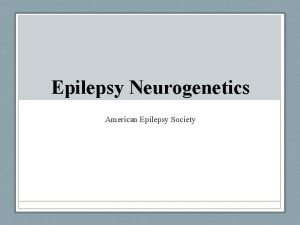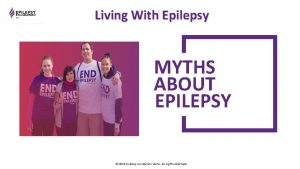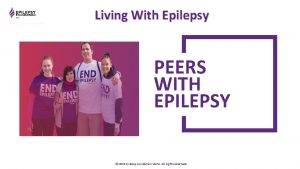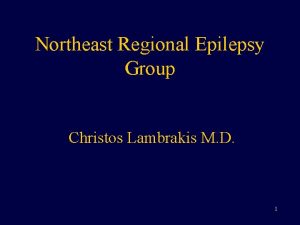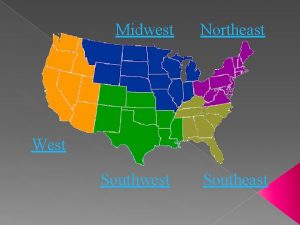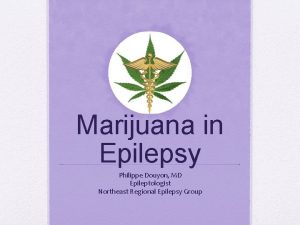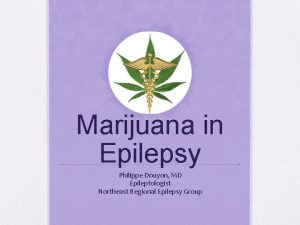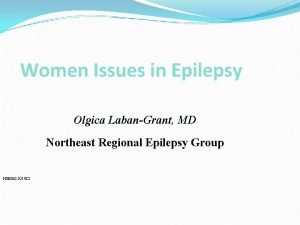Northeast Regional Epilepsy Group Do children with epilepsy


































































































- Slides: 98

Northeast Regional Epilepsy Group Do children with epilepsy have cognitive problems? How to ensure success in school

Robert W. Co-Director Clinical Neuropsychology NEREG

Children with epilepsy obtained lower scores than controls across measures of cognition and behavior. http: //pediatrics. aappublications. org/content/112/6/1338. short

Children with epilepsy often present with problems with cognitive functioning involving: -attention -executive functioning -memory -language.

Problems with cognitive functioning can cause other problems – notably social and academic difficulties

language troubles learning difficulties and poor academic performance behavior problems poor socio-professional prognosis Rijckevorsel (2006) http: //www. seizure-journal. com/article/S 1059 -1311%2806%2900036 -7/fulltext

Despite similar intelligence and educational background, significantly more patients with epilepsy (51%) than control subjects (27%) required special educational assistance. http: //pediatrics. aappublications. org/content/112/6/1338. short

attention -executive functioning -memory -language -

Factors behind cognitive difficulties among children with epilepsy

Epilepsy is a symptom rather than the cause of brain dysfunction.

There are structural changes that precede seizure onset

Some studies show that in newly diagnosed and untreated epileptic patients, cognitive problems are already present in more than 50% of patients http: //www. ncbi. nlm. nih. gov/pmc/articles/PMC 1797884/

Epileptic seizures can cause changes within the brain which can further affect cognitive functioning

An ongoing epileptogenic process can irreversibly damage the brain, especially the maturing brain, even if seizures are controlled

and can cause persistent cognitive changes and global intellectual deficits

Regarding seizures factors which can impact changes in cognitive functioning include: seizure type age of onset severity and frequency

anatomical location and etiology psychosocial problems and side effects of antiepileptic drugs. http: //www. ncbi. nlm. nih. gov/pmc/articles/PMC 3362729/

In addition to seizures, there associated disorders which can impact functioning

Attention Deficit Hyperactivity Disorder (ADHD)

ADHD subtypes ADHD – Combined Type ADHD – Predominantly Inattentive Type ADHD – Predominantly Hyperactive -Impulsive Type Other Specified ADHD Other Nonspecified ADHD

DSM-5 Criteria People with ADHD show a persistent pattern of inattention and/or hyperactivity-impulsivity that interferes with functioning or development: http: //www. cdc. gov/ncbddd/adhd/diagnosis. html

Inattention: Six or more symptoms of inattention for children up to age 16, or five or more for adolescents 17 and older and adults; symptoms of inattention have been present for at least 6 months, and they are inappropriate for developmental level: Often fails to give close attention to details or makes careless mistakes in schoolwork, at work, or with other activities. Often has trouble holding attention on tasks or play activities. Often does not seem to listen when spoken to directly. Often does not follow through on instructions and fails to finish schoolwork, chores, or duties in the workplace (e. g. , loses focus, side-tracked). Often has trouble organizing tasks and activities. Often avoids, dislikes, or is reluctant to do tasks that require mental effort over a long period of time (such as schoolwork or homework). Often loses things necessary for tasks and activities (e. g. school materials, pencils, books, tools, wallets, keys, paperwork, eyeglasses, mobile telephones). Is often easily distracted Is often forgetful in daily activities.

Hyperactivity and Impulsivity: Six or more symptoms of hyperactivityimpulsivity for children up to age 16, or five or more for adolescents 17 and older and adults; symptoms of hyperactivity-impulsivity have been present for at least 6 months to an extent that is disruptive and inappropriate for the person's developmental level: Often fidgets with or taps hands or feet, or squirms in seat. Often leaves seat in situations when remaining seated is expected. Often runs about or climbs in situations where it is not appropriate (adolescents or adults may be limited to feeling restless). Often unable to play or take part in leisure activities quietly. Is often "on the go" acting as if "driven by a motor". Often talks excessively. Often blurts out an answer before a question has been completed. Often has trouble waiting his/her turn. Often interrupts or intrudes on others (e. g. , butts into conversations or games)

In addition, the following conditions must be met: Several inattentive or hyperactive-impulsive symptoms were present before age 12 years. Several symptoms are present in two or more setting, (e. g. , at home, school or work; with friends or relatives; in other activities). There is clear evidence that the symptoms interfere with, or reduce the quality of, social, school, or work functioning. The symptoms do not happen only during the course of schizophrenia or another psychotic disorder. The symptoms are not better explained by another mental disorder (e. g. Mood Disorder, Anxiety Disorder, Dissociative Disorder, or a Personality Disorder).

Prevalence in the general population 11% of US school aged children received a diagnosis of ADHD by a health care provider by 2011 as reported by parents http: //www. cdc. gov/ncbddd/adhd/features/key-findings-adhd 72013. html

6. 4 million children including 1/5 high school boys 1/11 high school girls

among children with epilepsy between 12 and 17% prevalence of ADHD http: //www. ncbi. nlm. nih. gov/pubmed/21310586

higher occurrence of ADHD – inattentive type seizure/epilepsy variables do not seem to be important correlates

Regarding attention, there may be problems managing both internal and external stimuli.

Problems with attention – internal

Internal distractions – thought processes

Which can include concentrating on managing their own behavior, which can cause problems actually focusing on lessons

2015 study demonstrated that children with ADHD allowed to move functioned better on working memory tasks Authors suggested that the results likely would generalize to the classroom, allowing children to likely spend less time trying to control themselves http: //link. springer. com/article/10. 1007%2 Fs 10802 -015 -0011 -1

In Classroom: opportunities to move while working standing up while working sewing pedal for tapping squeeze balls while listening/reading

Problems with attention – external

Problems managing distractibility – sights and sounds

managing distractions tv, radio, internet, phones

other people can be a distraction

Preferential seating in the classroom

Separate location for tests/quizzes

Quiet place to work at home

other work on a table/desk can be a distraction (or anxiety producing)

Problems with Executive Functioning

- starting tasks - organizing/prioritizing tasks - planning/breaking down tasks - catching/correcting mistakes (self monitoring) - finishing tasks

Memory Problems

Problems with Learning Often Linked to Attention Problems

How to address these problems?

WORK HARDER

WORK HARDER DO BETTER

WORK HARDER DO BETTER DO MORE

perhaps not best approach

school services – programs, accommodations

IEP – special services plus accommodations through the Individuals with Disabilities Education Act (IDEA)

requires school to provide an individualized education program (IEP) designed to meet a child's unique needs and set up measurable growth/goals through accommodations, modifications, therapies, class placements or even different school settings

504 plan – accommodations civil rights law that ensures that a child with a disability has equal access to an education, through accommodations and modifications. http: //www. wrightslaw. com/info/sec 504. index. htm 3

What are some accommodations? Highlighted textbooks Extended time on tests or assignments Separate location for tests/quizzes Peer assistance with note taking Frequent feedback Extra set of textbooks for home use

Enlarged print Positive reinforcements Behavior intervention plans Rearranging class schedules Visual aids Preferential Seating Oral tests

silent reminders from teachers regarding behaviors Visual reminders including: schedules on the board assignments on board (same place, each day) so can be copied easily recognizing good behavior immediately pointing out off task behavior

Diagnoses warranting Services/Accommodations ADHD

Learning Disorders -Reading -Written Expression -Mathematics

The diagnosis requires persistent difficulties in reading, writing, arithmetic, or mathematical reasoning skills during formal years of schooling.

Symptoms may include inaccurate or slow and effortful reading poor written expression that lacks clarity difficulties remembering number facts or inaccurate mathematical reasoning

Current academic skills must be well below the average range of scores in culturally and linguistically appropriate tests of reading, writing, or mathematics.

The individual’s difficulties must not be better explained by developmental, neurological, sensory (vision or hearing), or motor disorders and must significantly interfere with academic achievement, occupational performance, or activities of daily living.

Differences between expectations and performances based on history Usually assessed with formal evaluations of IQ and achievement

When ability levels are lower than expected given overall level of functioning (IQ), special education classes may be necessary for further development of skills

How to get those accommodations? Contact the school regarding setting up a meeting regarding a potential need for special education services

Schools typically have professionals available to do evaluations to determine appropriateness of services However, neuropsychologists can also do these types of evaluations

Treating neurologists typically refer children with academic issues for a neuropsychological evaluation to aid the process of getting said services

Importance of letting treating neurologist know about any concerns about cognitive functioning (problems focusing, remembering) and academic functioning (problems grasping concepts, grade retention, poor grades)

Changes in environment/ approach at school

Changes in environment/ approach at home

Minimizing potential distractions such as tv radio internet phone

Learning how to study Avoiding cramming Spreading out studies over the course of several days (“overlearning”)

Learning how to study Studying with other people Quizzing each other Self-quizzing

Executive Skills – Planning/Organization Managing Workloads learning how to break down a project learning how to break down a reading assignment

Executive Functions. Planning/organization Keeping track of assignments on paper Putting homework assignments to complete in folder Pausing before leaving school to make sure have all needed papers/books putting away assignments in folder upon completion - immediately

Executive Functions – Planning/Organization Making checklists of assignments and projects Using a calendar to plan ahead critical points

Executive Functions. Prioritizing/Organization approach most difficult work first shifting to other work or taking breaks as necessary

Executive Functions Planning/Organization brainstorming ideas for writing making notes/outline drafts/editing

students need to be taught these skills

skills can be taught

medication?

percentage children ages 4 -7 years taking medication for ADHD, as reported by parents increased by 28% between 2007 and 2011 4. 8% in 2007 6. 1% in 2011 average increase about 7% per year http: //www. ncbi. nlm. nih. gov/pubmed/21310586

ADHD medications can lower seizure threshold http: //www. ncbi. nlm. nih. gov/pubmed/21310586

What can parents do? Contacting school regarding potential need for services/accommodations Regular communication with teachers/school staff regarding concerns and medical issues Helping children organize/manage assignments Helping children get started on tasks, moving back/helping as needed Checking over children’s work

Summary Seizures are associated with: Cognitive problems

Summary Seizures are associated with: Academic problems

Summary Seizures are associated with: Behavioral problems

problems can be managed with - school services/accommodations

problems can be managed with -communication with school staff

problems can be managed with -efforts at home regarding strategies

problems can be managed with -medication (where appropriate)

Treatment is ongoing and involves many people

Medical staff need to be updated on changes in functioning (cognitive, academic, and behavioral) so that changes in treatment can be made

Regular meetings with school staff can be helpful regarding making changes in programs

Children need to feel supported and encouraged

Thank you and questions
 Northeast epilepsy group
Northeast epilepsy group Northeast regional epilepsy
Northeast regional epilepsy Northeast regional epilepsy
Northeast regional epilepsy Xl spikes on eeg
Xl spikes on eeg All the states in the northeast region
All the states in the northeast region Northeast physical characteristics
Northeast physical characteristics The northeast states and capitals
The northeast states and capitals Tarrant county community college northeast
Tarrant county community college northeast West midwest south northeast
West midwest south northeast Northeast big data innovation hub
Northeast big data innovation hub Is athens northeast of sparta
Is athens northeast of sparta Western ap style
Western ap style Northeast florida state hospital
Northeast florida state hospital Northeastern vine supply
Northeastern vine supply Midwest region wa
Midwest region wa Northeast georgia council bsa
Northeast georgia council bsa Northeast, southeast, northwest, southwest
Northeast, southeast, northwest, southwest Northeast lean conference
Northeast lean conference Northeast monsoon sri lanka
Northeast monsoon sri lanka Northeast climate hub
Northeast climate hub From an iron post proceed 500 m northeast
From an iron post proceed 500 m northeast Northeast isd
Northeast isd Epilepsy ilae 2017
Epilepsy ilae 2017 Myoclonic vs tonic clonic seizure
Myoclonic vs tonic clonic seizure Canadian league against epilepsy
Canadian league against epilepsy Seizure vs syncope
Seizure vs syncope Nyu epilepsy center phone number
Nyu epilepsy center phone number Basic mechanisms underlying seizures and epilepsy
Basic mechanisms underlying seizures and epilepsy Aremco epilepsy
Aremco epilepsy Wake forest neurology residency
Wake forest neurology residency Epilepsy
Epilepsy Seizure triggers
Seizure triggers Epilepsy and seizure services near sutter creek
Epilepsy and seizure services near sutter creek European epilepsy database
European epilepsy database Difference between seizure and epilepsy
Difference between seizure and epilepsy Catastrophic epilepsy infancy
Catastrophic epilepsy infancy Post ictal state
Post ictal state Cps epilepsy
Cps epilepsy Letazol
Letazol Epilepsy
Epilepsy Depakote epilepsy
Depakote epilepsy Reversible dementia
Reversible dementia Epilepsy
Epilepsy Cerebellar dysfunction
Cerebellar dysfunction Terratogenesis
Terratogenesis Epilepsy
Epilepsy Epilepsy death
Epilepsy death Benign rolandic epilepsy icd 10
Benign rolandic epilepsy icd 10 Ykp epilepsy
Ykp epilepsy Dr zawadzki
Dr zawadzki What to do if someone has a seizure
What to do if someone has a seizure Aremco epilepsy
Aremco epilepsy Catamenial epilepsy and birth control pills
Catamenial epilepsy and birth control pills Sfinn
Sfinn Spina bifida and epilepsy
Spina bifida and epilepsy Young epilepsy
Young epilepsy American epilepsy society annual meeting 2017
American epilepsy society annual meeting 2017 Dr politsky epilepsy
Dr politsky epilepsy Deindividuation psychology definition
Deindividuation psychology definition Y = a(b)^x
Y = a(b)^x Anova within group and between group
Anova within group and between group Primary group
Primary group Joint royal college of physicians training board
Joint royal college of physicians training board Thermal stability of group 2 carbonates and nitrates
Thermal stability of group 2 carbonates and nitrates Amino group and carboxyl group
Amino group and carboxyl group Amino group and carboxyl group
Amino group and carboxyl group In group out group
In group out group Group yourself or group yourselves
Group yourself or group yourselves William graham sumner in group out group
William graham sumner in group out group Joining together group theory and group skills
Joining together group theory and group skills Regional area network
Regional area network Neck anatomical term
Neck anatomical term Va's maximum loan amount for 100 financing is $144 000
Va's maximum loan amount for 100 financing is $144 000 Centro universitario de azuero
Centro universitario de azuero Covert speech style
Covert speech style National vs regional
National vs regional Regional technical forum
Regional technical forum Organisational structure of rrb
Organisational structure of rrb Ecuador customs
Ecuador customs Advantages and disadvantages of regional integration
Advantages and disadvantages of regional integration Regional enhet for behandlingshjelpemidler
Regional enhet for behandlingshjelpemidler Regional center for border health san luis az
Regional center for border health san luis az Rcsu pacific
Rcsu pacific Regional and social dialect in sociolinguistics
Regional and social dialect in sociolinguistics Shasta regional wound care
Shasta regional wound care Pnp seal and meaning
Pnp seal and meaning Complexo regional
Complexo regional North texas regional certification agency
North texas regional certification agency Nhslsf
Nhslsf Micro enterprise credential exam
Micro enterprise credential exam Regional metamorphism
Regional metamorphism Mutual intelligibility
Mutual intelligibility Regional automated property information database
Regional automated property information database Luce township regional sewer district
Luce township regional sewer district What is regionalization
What is regionalization Resume chapitre 26 le dernier jour d un condamné
Resume chapitre 26 le dernier jour d un condamné Lagan valley regional park
Lagan valley regional park Kerr lake regional water system
Kerr lake regional water system Indian mounds regional park
Indian mounds regional park

